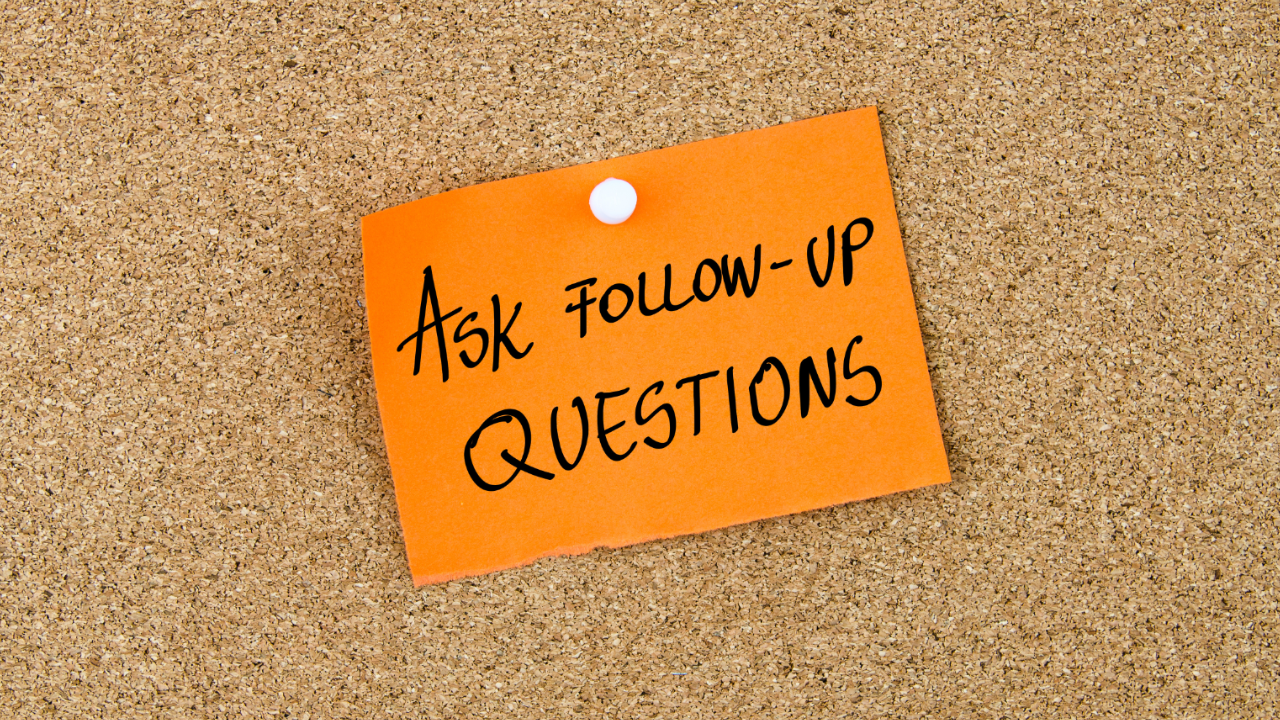Asking Follow-Up Questions


A week or so before a board meeting, savvy directors start their PREP work to make sure they’ll be ready to take an active part in the meeting and add real value to the board’s discussions. Part of their PREP work is compiling a list of potential questions to ask – the kind of great questions that get to the heart of issues and help the board move forward.
The management team is probably thinking about questions too. What questions might they have for board members that will help draw out the insight and foresight that the board is there to provide? And what questions might they anticipate receiving in response to their reports, presentations, or proposals?
Here at DirectorPrep we’re heartily in favor of arriving at the meeting with a list of prepared questions in your pocket. In fact, doing so is one of The Six Key Habits of The Savvy Director. But it’s important to recognize that, if you rely solely on your prepared list, you won’t be as effective as you want to be in ferreting out the information you’re after.
Many times, the initial answer to a question is only marginally helpful or even totally irrelevant. Asking a follow-up question or two can help you uncover what you’re really seeking to learn. Good follow-up questions dig a little deeper to bring insights into the light of day.
Unless they’re really intentional about it, people often don’t ask follow-up questions. More often than not, they ask their initial question and stop there, or perhaps move on to the next question on their list.
There are two reasons for this lack of follow-up. The first is that, many times, questioners don’t actually pay attention to the answer to their initial question. To ask a good follow-up question, you need to listen carefully, pay close attention to the response, and then build on that response.
The second reason for lack of follow-up questions is fear of offending the other person. No one wants a conversation to sound like an interrogation. However, it’s interesting to note that research shows that follow-up questions, when asked carefully, actually build trust because they show you’re listening and you’re genuinely interested.
Having said that, it’s important to realize that the dynamics can change significantly when you’re talking in a group – such as a board of directors – instead of one-on-one.
Pay Attention to Group Dynamics
While researching this topic, I didn’t find many experts writing about follow-up questions in the boardroom. Most of the articles – even the ones you’ll find listed in the Resources section below – deal with follow-up questions in the context of conversations or interviews. But many of their observations make just as much sense when applied in a boardroom environment - as long as you factor in the procedures and dynamics that make board discussions unique.
For one thing, group dynamics affect how a questioner is perceived. The person who is busy asking questions is viewed less positively than the one who is answering them. A board member who asks the same question repeatedly or probes into details can seem rude and invasive to their fellow directors.
To counteract this effect, the questioner can make short personal asides or include phrases like, “I want to make sure I understand,” or “Let me ask this a different way.” This kind of phrase makes the interaction seem less like an interrogation and more like a conversation.
Group dynamics also drastically affect a person’s willingness to answer questions. It’s no surprise that members of a group tend to follow one another’s lead. We’ve all seen it happen in board meetings. It takes only a few closed-off people for questions to lose their probing power, and soon the discussion just runs out of steam.
On the other hand, as soon as one person starts to open up, the rest of the group is likely to follow. That’s why it’s important to make sure your questions – both initial and follow-up – are posed in a neutral and non-threatening way. It helps ensure that the person responding feels safe to open up and sets a positive tone for the whole discussion.
When to Ask Follow-Up Questions
In the context of boardroom discussion, follow-up questions are not always possible. In the interests of time, the board chair may want to move the discussion along as soon as your initial question is answered. And to make sure everyone gets a chance to speak, they may recognize another director immediately. You may not get a chance to ask a follow-up until your turn comes around again, and by that time it may no longer be relevant or even appropriate.
Still, you’ll probably find that there are times when the opportunity to follow-up is available to you – maybe because there are no other directors with questions, or the discussion hasn’t really taken off yet. In such cases, you can use a follow-up question to zoom in to get details when the initial response was too broad or unclear. Or, if you already have enough details, you can zoom out for more context or to make sure there’s nothing important left out.
Here are a few familiar boardroom situations where follow-up questions could prove useful and productive.
The initial answer is short, incomplete, or too general. When there are interesting details you want to dig into, try asking “Can you tell me more about that?” or “I want to make sure I understand. Can you explain it further?”
The person answering uses unclear terms. When the initial answer includes vague language like often, sometimes, or rarely, try asking “Can you be more specific? How often does this happen?” If they use unfamiliar jargon or there are many possible interpretations of their answer, follow-up with “You mentioned [term or phrase]. Can you help me understand that better?”
The person avoids answering a question. The person answering might misinterpret your initial question, or they might be deliberately avoiding it. In these situations, your best bet is to restate the initial question in a slightly different way.
The person answering goes off on a tangent. This happens often in boardrooms. Management has something they want to say, and they try to divert your question to that topic. If your question hasn’t been answered, wait till the person pauses and then use a follow-up question such as “How does this relate to the topic we started with?”
You’ve asked a really hard question. If the person answering hesitates or stumbles when answering, try restating the question from a different perspective. It gives them more time to think about their response and gets them to dig further.
Your question triggers a strong emotion. If the person answering gets angry or defensive, or displays another strong emotion, ask if they want to continue. If they do, ask a follow-up question that acknowledges their feelings such as “Do you want to say something about why this topic generated such strong emotion for you?” or “Why is this so important to you?”

How to Ask Follow-Up Questions
There are a few useful techniques for asking good follow-up questions.
Simply ask for elaboration. This is the simplest kind of follow-up question. Never hesitate to just ask someone to elaborate. As long as you ask respectfully and with genuine curiosity, people are happy to tell you more. Say something like, “Could you tell me a little bit more about that?”
Ask the initial question in a different way. This technique is a favorite of interviewers, but it could definitely be useful in the boardroom. It simply involves asking the same question twice, making sure to change the way you phrase the follow-up question so it doesn’t seem adversarial.
Your restated question might use a synonym. For instance, instead of asking about risks, you could ask about worries, or just ask “What keeps you up at night?” Another method of restating the question is to invite a different perspective by asking what someone else would think of the issue. For instance, ask “What would our customers think about that?”
The restating technique is effective because you communicate that you’re not letting the person off the hook. To make it work, precede the follow-up with words such as, “Let me ask this another way…”. It allows them to save face by implying that maybe your initial question wasn’t clear enough.
Connect answers together. This technique involves listening intently and then linking the response to something that was said earlier. You could ask something like, “Oh, that’s like the time you…?” or, “Is that what you meant earlier when you said…?”. This not only communicates that you’re really listening, but it points out connections that others may not have seen.
Using this technique, your role is to synthesize, not to interrogate. To make it work, avoid saying things like, “But that’s not what you said earlier.”
Ask about the implications of their initial answer. This technique is useful when the initial answer is overly safe and not very revealing. You can ask about the implications of their answers with follow-up questions like “How does that play out in real life?” or “What are the consequences of this action?”
To make this work, make sure you show genuine curiosity about what you’re hearing. Avoid asking leading questions or approaching the discussion as though you're litigating a legal case.
Challenge generalizations. This technique is useful to try to pin down facts. When people make generalizations, they’re usually saying more about their feelings than about facts. Terms like never or always invite follow-up questions that get the person to quantify (“You said ‘always’ but I’d like to understand that better. How often does it occur?”), compare (“How does that compare to the industry?”), or slow down (“Let’s take a step back. Could you walk me through this more slowly?”)
Follow-Up Favorites
If you’re looking for a few follow-up staples, try any of the following:
- “Can you give me an example of … ?”
- “Tell me more about … .”
- “What do you mean by … ?”
- “I want to make sure I understand. You said … . Did I get that right?”
- “How do we know that … ?”
- "Have you thought about ... ?"
Your takeaways:
- If you rely solely on a list of prepared questions, you won’t be as effective as you want to be in ferreting out information.
- Asking good follow-up questions lets you dig a little deeper to bring insights into the light of day.
- When you have an opportunity to ask a follow-up question in a board meeting, you can use it to zoom in to get details when the initial response was too broad or unclear, or to zoom out for more context or to make sure there’s nothing important left out.
- Good follow-up questions show genuine curiosity, demonstrate that you’re listening, and allow you to add real value to board discussions.
Resources:
- A beginner’s guide to asking follow-up questions in user interviews. Taylor Nguyen. UX Collective. May 2020.
- The Definitive Guide to Asking Follow-up Questions. Dan Brown. Medium. August 2019.
- The Surprising Power of Questions. Alison Wood Brooks and Leslie K. John. Harvard Business Review. May-June 2018.
- Tactics for Asking Good Follow-Up Questions. Richard Davis. Harvard Business Review. November 2014.
Thank you.
Scott
Scott Baldwin is a certified corporate director (ICD.D) and co-founder of DirectorPrep.com – an online membership with practical tools for board directors who choose a growth mindset.
Originally published July 10, 2022
We Value Your Feedback: Share your suggestions for future Savvy Director topics.
Comment



